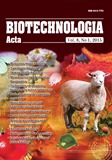ISSN 2410-776X (Online),
ISSN 2410-7751 (Print)

Biotechnologia Acta, V. 8, No 1, 2015;
https://doi.org/10.15407/biotech8.01.056
P. 56-62, Bibliography 19, English
Universal Decimal classification: 58.085.2:582.542.11:631.811.98
I. R. Gorbatyuk 1, A. V. Bavol 1, 2, A. V. Holubenko 1, 3, B. V. Morgun 1, 2
1 Institute of Cell Biology and Genetic Engineering, National Academy of Sciences of Ukraine, Kyiv
2 Institute of Plant Physiology and Genetics, National Academy of Science of Ukraine, Kyiv
3 Taras Shevchenko National University of Kyiv, Ukraine
The aim of the study was to determine the dependence of morphogenetic reactions of wheat callus tissues to content of syntetic growth regulators of auxin nature (picloram, dicamba) in the nutrient medium.
Apical meristems of Triticum aestivum wheat were the primary explants for callusogenesis. Basic culture medium MS supplemented by vitamins of Gamborg, dicamba at different concentrations (0.2, 0.4, 0.6 mg/l), and picloram (0.16; 0.25; 0.5 mg/l) was used for regeneration. It was established that dicamba at a concentration of 0.2 mg/l is the most effective for production of regenerants. It was also observed that at the concentration of 0.16 mg/l picloram there are the formation of the greatest number of morphogenic zones (60%) and a significant amount of plant-regenerants. Increased concentrations of picloram to 0.25 mg/l and 0.5 mg/l caused a decrease in the number of morphogenic islands: in the first case, 10%, and the second – 36.4%. Among the described options the MS medium supplemented with 0.5 mg/l 6-benzylaminopurine and 0.16 mg/l picloram was the most effective. Shoots obtained from callus culture were capable to form roots in vitro and adapt to septic conditions. Regenerated plants when cultivated in greenhouse showed high viability (over 75%) and reached the generative phase.
Key words: growth regulators, picloram, dicamba, Triticum aestivum, in vitro culture.
© Palladin Institute of Biochemistry of the National Academy of Sciences of Ukraine, 2015
References
1. Benderradji L., Brini F., Kellou K., Ykhlef N., Djekoun A., Masmoudi K., Bouzerzour H. Callus induction, proliferation, and plantlets regeneration оf two bread wheat (Triticum aestivum L.) genotypes under saline and heat stress conditions. Int. Schol. Res. Network. 2012, P. 1–8.
2. Sharma V. K., Hansch R., Mendel R.R, Schulze J. Influence of picloram and thidiazuron on high frequency plant regeneration in elite cultivars of wheat with long-term retention of morphogenecity using meristematic shoot segments. Plant Breed. 2005, V. 124, P. 242–246.
http://dx.doi.org/10.1111/j.1439-0523.2005.01095.x
3. Becher T., Haberland G., Koop H. Callus formation and plant regeneration in standard and microexplants from seedlings of barley (Hordeum vulgare L.). Plant Cell Rep. 1992, V. 11, P. 39–43.
http://dx.doi.org/10.1007/BF00231837
4. Curtis I. S., Nam. H. G. Transgenic radish (Raphanus sativus L. Longipinnatus Bailey) by floral-dip method – plant development and surfactant are important in optimizing transformation efficiency. Transg. Res. 2001, V. 10, P. 363–371.
http://dx.doi.org/10.1023/A:1016600517293
5. Chen Jun-Ying, Yue Run-Qing, Xu Hai-Xia, Chen Xin-Jian. Study on plant regeneration of wheat mature embryos under endosperm-supported culture. Agricult. Sci. China. 2006, 5 (8), 572–578.
http://dx.doi.org/10.1016/S1671-2927(06)60094-1
6. Fazeli-nasab B., Omidi M., Amiritokaldani M. Callus induction and plant regeneration of wheat mature embryos under abscisic acid treatment. Int. J. Agricult. Crop Sci. 2012, V. 4, P. 17–23.
7. Holubenko A. V. Studies of morphogenesis Gentiana macrophylla pall. In sterile culture conditions. Vydavnychyi tsentr «Kyivskyi unіversytet», Vіsnyk Kyivskoho natsіonalnoho unіversytetu «Іntroduktsіia ta zberezhennia roslynnoho rіznomanіttia». 2004, V. 7, P. 52–53. (In Ukrainian).
8. Kruglova N. N., Seldimirova O. A., Zaitsev D. Y., Katasonova A. A. Biotechnological evaluation of explants for obtaining regenerated in vitro plants of spring wheat for adaptive selection in the conditions of the Southern Urals. Izv. Chelyab. NCUrО RАN. 2006, 2 (32), 94–98. (In Russian).
9. Kruglova N. N., Dubrovnaya O. V. Morphogenesis of cereal androclinal calluses in vitro. Fiziologiia i biokhimiia kulturnykh rastenii. 2011, 43 (1), 15–25. (In Russian).
10. Gopitha K., Lakshmi Bhavani A., Senthilmanickam J. Effect of the different auxins and cytokinins in callus induction, shoot, root regeneration in sugarcane. Int. J. Pharma Bio Sci. 2010, V. 1, P. 1–7.
11. Ying-Hua Su, Yu-Bo Liu, Xian-Sheng Zhang. Auxin–cytokinin interaction regulates meristem development. Mol. Plant. 2011, 4 (4), 616–625.
http://dx.doi.org/10.1093/mp/ssr007
12. Bavol A. V., Dubrovna O. V., Lialko І. І. Regeneration of plants from shoot tips explants of wheat sprouts. Vіsnyk Ukrainskoho tovarystva henetykіv і selektsіonerіv. 2007, 5 (1–2), 3–10. (In Ukrainian).
13. Bavol A. V., Dubrovna O. V., Lialko І. І., Zіnchenko M. O. Effect of thidiazuron on the processes of morphogenesis in culture in vitro of wheat. Fiziolohiia i biokhimiia kulturnykh rastenii. 2011, V. 5, P. 412–418. (In Ukrainian).
14. Murashige T., Skoog F. A revised medium for rapid growth and bioassays with tobacco tissue cultures. Phys. Plant. 1962, 15 (3), 473–497.
15. Gamborg O. L., Eveleigh D. E. Culture methods and detection of glucanases in cultures of wheat and barley. Can. J. Biochem. 1968, 46 (5), 417–421.
16. Musienko M. M., Paniuta O.O. Plant biotechnology. Tutorial. Kyiv: Vyd.-polihraf. tsentr «Kyivskyi universytet», 2005, 114 p. (In Ukrainian).
17. Eudes F., Achatya S., Laroche A., Selinger L. B., Cheng K.-J. A novel method to induce direct somatic embryogenesis, secondary embryogenesis and regeneration of fertile green cereal plants. Plant Cell Tiss. Org. Cult. 2003, 73 (2), 147–157.
http://dx.doi.org/10.1023/A:1022800512708
18. Timofeeva O. A., Rumjanceva N. I. Culture of cells and tissues of plants. Textbook. Kazan: Kazanskii (Privolzhskii) federalnyy universitet, 2012, 91 p. (In Russian).
19. Butenko R. G. Culture isolated tissues and physiology of plant morphogenesis. Moskva: Nauka, 1964, 272 p. (In Russian).

